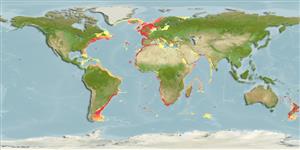Environment: milieu / climate zone / depth range / distribution range
Écologie
marin démersal; océanodrome (Ref. 51243); profondeur 40 - 600 m (Ref. 7251), usually 100 - 200 m (Ref. 36731). Deep-water; 70°N - 55°S, 82°W - 179°E
Eastern Atlantic: Norway to South Africa (Ref. 6633), including the Mediterranean, Canary Islands, Madeira, Cape Verde, and Tristan da Cunha. Western Atlantic: Newfoundland, Canada and Gulf of Maine to North Carolina, USA (Ref. 7251). Recorded from Uruguay to Argentina (Ref. 9050). Western Indian Ocean: St. Paul and Amsterdam islands (Ref. 6633). Southwest Pacific: New Zealand (Ref. 5755, 9072).
Length at first maturity / Taille / Poids / Âge
Maturity: Lm 77.9 range ? - 90 cm
Max length : 210 cm TL mâle / non sexé; (Ref. 7251); common length : 80.0 cm TL mâle / non sexé; (Ref. 3397); poids max. publié: 100.0 kg (Ref. 35388); âge max. reporté: 80 années (Ref. 127279)
Description synthétique
Clés d'identification | Morphologie | Morphométrie
Épines dorsales (Total) : 10 - 12; Rayons mous dorsaux (Total) : 11 - 13; Épines anales: 3; Rayons mous anaux: 8 - 10. Bluish grey above, paler below with a silvery sheen; fins blackish brown (Ref. 6633). Juveniles have black blotches on head and body (Ref. 6633). Body tall, compressed. Big mouth with big head and a rough bony ridge across upper part of the gill cover (Ref. 35388).
Adults prefer to inhabit caves and shipwrecks (Ref. 27121). Juveniles congregate below floating objects (Ref. 27121). Usually solitary. Feed on large crustaceans, cephalopods and benthic fishes (Ref. 27121). Spawn in the summer (Ref. 35388). Are primary gonochorists (Ref. 58421). Marketed fresh or frozen; eaten steamed, fried, broiled, boiled, microwaved and baked (Ref. 9988). Minimum depth reported from Ref. 6633.
Primary gonochorists (Ref. 58421).
Wheeler, A., 1992. A list of the common and scientific names of fishes of the British Isles. J. Fish Biol. 41(suppl.A):1-37. (Ref. 5204)
Statut dans la liste rouge de l'IUCN (Ref. 130435: Version 2024-2)
Menace pour l'homme
Harmless
Utilisations par l'homme
Pêcheries: intérêt commercial mineur; pêche sportive: oui
Outils
Articles particuliers
Télécharger en XML
Sources Internet
Estimates based on models
Preferred temperature (Ref.
123201): 5.2 - 19, mean 9.4 °C (based on 672 cells).
Phylogenetic diversity index (Ref.
82804): PD
50 = 0.8125 [Uniqueness, from 0.5 = low to 2.0 = high].
Bayesian length-weight: a=0.01318 (0.00965 - 0.01801), b=3.00 (2.91 - 3.09), in cm total length, based on LWR estimates for this species (Ref.
93245).
Niveau trophique (Ref.
69278): 4.1 ±0.64 se; based on food items.
Résilience (Ref.
120179): Faible, temps minimum de doublement de population : 4,5 à 14 années (K=0.05-0.08; tmax=76; tm=9-10 yrs estimated from VBGF; Fec=3 million).
Fishing Vulnerability (Ref.
59153): Very high vulnerability (78 of 100).
Climate Vulnerability (Ref.
125649): Moderate to high vulnerability (50 of 100).
Nutrients (Ref.
124155): Calcium = 9.7 [6.1, 21.1] mg/100g; Iron = 0.354 [0.174, 0.670] mg/100g; Protein = 19.6 [19.0, 20.3] %; Omega3 = 0.427 [0.332, 0.549] g/100g; Selenium = 25 [11, 55] μg/100g; VitaminA = 7.95 [1.81, 35.92] μg/100g; Zinc = 0.253 [0.178, 0.380] mg/100g (wet weight); based on
nutrient studies.
